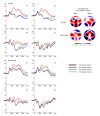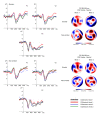Electrophysiological correlates of associative learning in smokers: a higher-order conditioning experiment
- PMID: 22235938
- PMCID: PMC3277456
- DOI: 10.1186/1471-2202-13-8
Electrophysiological correlates of associative learning in smokers: a higher-order conditioning experiment
Abstract
Background: Classical conditioning has been suggested to play an important role in the development, maintenance, and relapse of tobacco smoking. Several studies have shown that initially neutral stimuli that are directly paired with smoking are able to elicit conditioned responses. However, there have been few human studies that demonstrate the contribution of higher-order conditioning to smoking addiction, although it is assumed that higher-order conditioning predominates learning in the outside world. In the present study a higher-order conditioning task was designed in which brain responses of smokers and non-smokers were conditioned by pairing smoking-related and neutral stimuli (CS1smoke and CS1neutral) with two geometrical figures (CS2smoke and CS2neutral). ERPs were recorded to all CSs.
Results: Data showed that the geometrical figure that was paired with smoking stimuli elicited significantly larger P2 and P3 waves than the geometrical figure that was paired with neutral stimuli. During the first half of the experiment this effect was only present in smokers whereas non-smokers displayed no significant differences between both stimuli, indicating that neutral cues paired with motivationally relevant smoking-related stimuli gain more motivational significance even though they were never paired directly with smoking. These conclusions are underscored by self-reported evidence of enhanced second-order conditioning in smokers.
Conclusions: It can be concluded that smokers show associative learning for higher-order smoking-related stimuli. The present study directly shows the contribution of higher-order conditioning to smoking addiction and is the first to reveal its electrophysiological correlates. Although results are preliminary, they may help in understanding the etiology of smoking addiction and its persistence.
Figures







Similar articles
-
A smoking-related background helps moderate smokers to focus: An event-related potential study using a Go-NoGo task.Clin Neurophysiol. 2017 Oct;128(10):1872-1885. doi: 10.1016/j.clinph.2017.07.416. Epub 2017 Aug 5. Clin Neurophysiol. 2017. PMID: 28826017
-
Conditioned cues for smoking elicit preparatory responses in healthy smokers.Psychopharmacology (Berl). 2011 Feb;213(4):781-9. doi: 10.1007/s00213-010-2033-2. Epub 2010 Oct 15. Psychopharmacology (Berl). 2011. PMID: 20953588 Free PMC article.
-
Cue reactivity in smokers: an event-related potential study.Int J Psychophysiol. 2013 Nov;90(2):258-64. doi: 10.1016/j.ijpsycho.2013.08.005. Epub 2013 Aug 16. Int J Psychophysiol. 2013. PMID: 23958866 Free PMC article.
-
Electrophysiological CNS-processes related to associative learning in humans.Behav Brain Res. 2016 Jan 1;296:211-232. doi: 10.1016/j.bbr.2015.09.011. Epub 2015 Sep 11. Behav Brain Res. 2016. PMID: 26367470 Review.
-
Extending the role of associative learning processes in nicotine addiction.Behav Cogn Neurosci Rev. 2004 Sep;3(3):143-58. doi: 10.1177/1534582304272005. Behav Cogn Neurosci Rev. 2004. PMID: 15653812 Review.
Cited by
-
Conditioned cortical reactivity to cues predicting cigarette-related or pleasant images.Int J Psychophysiol. 2016 Mar;101:59-68. doi: 10.1016/j.ijpsycho.2016.01.007. Epub 2016 Jan 28. Int J Psychophysiol. 2016. PMID: 26826400 Free PMC article.
-
Early onset cigarette smokers exhibit greater P300 reactivity to smoking-related stimuli and report greater craving.Brain Res. 2018 May 15;1687:173-184. doi: 10.1016/j.brainres.2018.02.037. Epub 2018 Mar 7. Brain Res. 2018. PMID: 29524436 Free PMC article.
-
Intertemporal preference reversals are associated with early activation of insula and sustained preferential processing of immediate rewards in visual cortex.Sci Rep. 2021 Nov 15;11(1):22277. doi: 10.1038/s41598-021-01579-7. Sci Rep. 2021. PMID: 34782648 Free PMC article.
-
The reality of "food porn": Larger brain responses to food-related cues than to erotic images predict cue-induced eating.Psychophysiology. 2019 Apr;56(4):e13309. doi: 10.1111/psyp.13309. Epub 2018 Dec 16. Psychophysiology. 2019. PMID: 30556253 Free PMC article.
-
Internal consistency and test-retest reliability of the P3 event-related potential (ERP) elicited by alcoholic and non-alcoholic beverage pictures.Psychophysiology. 2022 Feb;59(2):e13967. doi: 10.1111/psyp.13967. Epub 2021 Nov 15. Psychophysiology. 2022. PMID: 34783024 Free PMC article.
References
-
- Davis JA, Gould TJ. Associative learning, the hippocampus, and nicotine addiction. Curr Drug Abuse Rev. 2008;1(1):9–19. - PubMed
Publication types
MeSH terms
LinkOut - more resources
Full Text Sources

